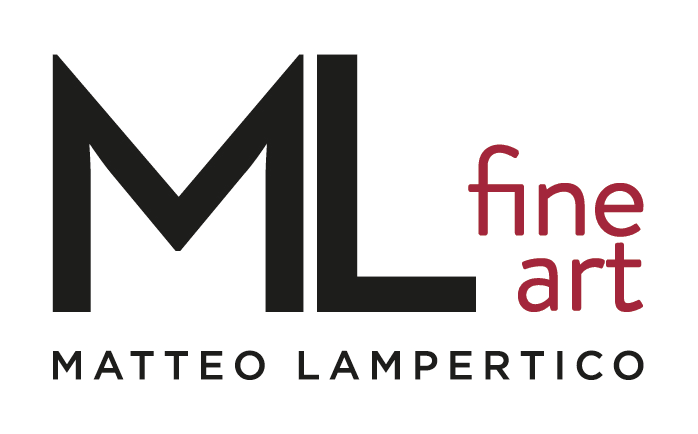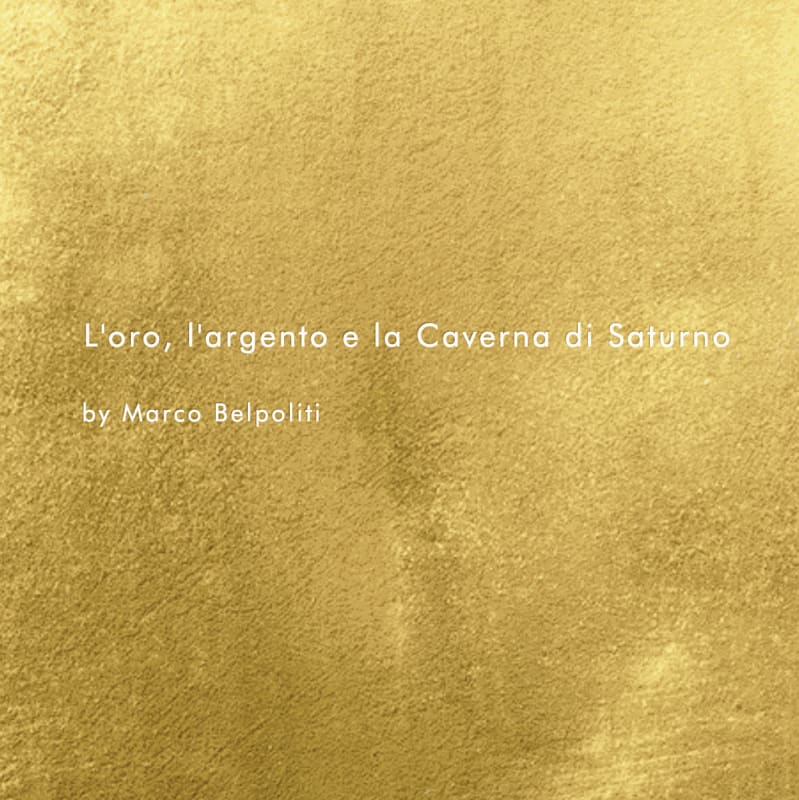L’oro, l’argento e la Caverna di Saturno
by Marco Belpoliti
Massimo Antonaci's art knows the darkness of black and the light of white, and gold. The latter is the color of reverence, the one that is granted to the gods and the divine, but also to oneself. Over the centuries, kings, emperors and artists have used gold to arouse awe and admiration, but also to illuminate the darkness and overcome the limit of white. The gold light is warm and strong, it is round and pointed. It never blackens, never clears up, it remains identical to itself.
In 1310 Giotto composed an altarpiece for the Church of All Saints now at the Uffizi in Florence. The characters in this painting stand out against a sumptuous gold background. Composed of very thin leaves obtained from coins of that metal beaten patiently and fervently, the work indicates the divine space that can only be inhabited in the condition of holiness. To make the gold sparkle, it had to be burnished, but as happens in that wonderful work of Giotto, the flat leaves make the surface something unreal: every shadow disappears and everything shines with a luminous intensity that alludes to the elsewhere, the place where gods rest. In the altarpiece, our other selves, purer and clearer, Paradise souls, are rendered in the form of earthly beings: men and women delegated to precede us in the radiant dimension.
The divine diffuses the same light and opens a door which, however attractive, will be difficult to pass through. In the wall there is gold, like a simulacrum of that world that wants to appear and escape, at the same time. Will we ever be able to enter and remain in its radiant beauty?
A sage once said that gold is the color of desire, precisely because it overcomes the black of darkness and the white of light altogether, because it desires what is right to desire. materical light, gold becomes shape and dimension, although it remains a thin, impalpable sheet. The thickness of gold is the most truthful attestation of its superficiality, so that even the heaviest jewel of this metal cannot challenge the will of the surface which blazes in gold.
If gold shines with the same light as the Sun, silver derives from the Moon, it is its material shadow. Unlike gold, silver has two faces: one bright and sparkling and the other black of darkness. Silver possesses the imperfection, which is found in most metals, and is linked to human nature for its ambivalence: one moment it shines and the next it sinks into dark patina. The moon is more human than the sun, as it is a cold realm where death dwells, and we humans are mortal. As astronomers tell us, it lives on reflected light, an opaque mirror in which to see our perfectible nature. Sun and Moon, male and female, gold and silver, separated can live for a long time, united they deny each other, however much they always attract and seek each other.
Massimo Antonaci is an artist who lives under the sign of Saturn. He does not possess the prerogatives of Mercury, god of trade and commerce, protector of thieves, divinity who wears winged sandals. His temperament is melancholy and his posture is that of a man who reflects. His season is autumn and his color is sunset red. He meditates and supports with his hand the head that weighs: pondus. Weighing and thinking [pesare and pensare] have the same root. To snatch from Saturn the gold he needs, he must descend the caves where Cronus imprisoned the Giants. An initiatory journey much like every work that Antonaci composes. Down there it is darkness and obscurity, down there gold shines with its own light. It is not a descent into the Underworld, but a journey towards the bowels of the Earth where all metals are contained and from which Zeus-Saturn comes from, the castrating god who rules creativity.
Massimo Antonaci's artworks tempt us with their absoluteness, with their desire for purity and the absolute. The artist now walks on a tightrope, suspended from the ground between one and the other trace of light. He wants us to glimpse a possible way to salvation. Art loses us, art saves us.
____________________________________________________________________________________________________
L’oro, l’argento e la Caverna di Saturno
di Marco Belpoliti
L’arte di Massimo Antonaci conosce le tenebre del nero e la luce del bianco, e l’oro. Quest’ultimo è il colore della riverenza, quella che si concede agli dei e al divino, ma anche a sé stessi. Nei secoli re, imperatori, artisti hanno utilizzato l’oro per suscitare soggezione e ammirazione, ma anche per illuminare le tenebre e superare il limite del bianco. La luce dell’oro è calda e forte, è tonda e puntuta. Mai si annerisce, mai si schiarisce, resta identica a sé stessa.
Giotto nel 1310 compose una pala d’altare destinata alla Chiesa d’Ognissanti oggi conservata agli Uffizi a Firenze. I personaggi di questa pittura si stagliano su un suntuoso fondo oro. Composto di foglie sottilissime ottenute da monete di quel metallo battute in modo paziente e fervente, l’opera indica lo spazio divino che si può abitare solo nella condizione della santità. Per fare scintillare l’oro bisognava brunirlo, ma come accade in quella meravigliosa opera di Giotto le piatte foglie rendono la superficie qualcosa d’irreale: ogni ombra scompare e tutto riluce d’una intensità luminosa che allude all’altrove, il luogo dove riposano le divinità. Nella pala altri noi stessi, più puri e tersi, anime del Paradiso, vengono resi sotto forma di esseri terreni: uomini e donne delegati a precederci nella dimensione irradiante.
Il divino diffonde la medesima luce e apre una porta che, per quanto attraente, sarà difficile attraversare. Nel muro c’è l’oro come un simulacro di quel mondo che vuole apparire, e contemporaneamente sottrarsi. Potremo mai entrare e permanere nella sua bellezza irradiante?
Un saggio ha detto una volta che l’oro è il colore del desiderio, proprio perché supera insieme il nero delle tenebre e il bianco della luce, perché desidera ciò che è giusto desiderare. Luce materica, l’oro diventa forma e dimensione, per quanto resti una sottile lamina impalpabile. Lo spessore dell’oro è l’attestato più veritiero della sua superficialità, così che anche il monile più pesante di questo metallo non può sfidare la volontà della superfice che arde nell’oro.
Se l’oro brilla della stessa luce del Sole, l’argento deriva dalla Luna, ne è la sua ombra materica. A differenza dell’oro, l’argento ha due facce: una luminosa e scintillante e l’altra nera delle tenebre. L’argento possiede l’imperfezione, che è della maggior parte dei metalli, e si lega alla natura umana per la sua ambivalenza: un momento brilla e un momento dopo s’inabissa nella patina scura. La luna è più umana del Sole, poiché è un regno freddo in cui abita la morte, e noi uomini siamo mortali. Come ci dicono gli astronomi vive di luce riflessa, uno specchio opaco in cui scorgere la nostra natura perfettibile. Sole e Luna, maschile e femminile, oro e argento, separati possono vivere a lungo, uniti si negano a vicenda, per quanto sempre s’attraggano e si cerchino.
Massimo Antonaci è un artista che vive sotto il segno di Saturno. Non possiede le prerogative di Mercurio, dio degli scambi e dei commerci, protettore dei ladri, divinità che calza i sandali alati. Il suo temperamento è melanconico e la sua postura è quella dell’uomo che riflette. La sua stagione è l’autunno e il suo colore è il rosso del tramonto. Medita e sorregge con la mano il capo che pesa: pondus. Pesare e pensare hanno la medesima radice. Per strappare a Saturno l’oro di cui ha bisogno egli deve scendere nelle caverne dove Crono imprigionò i Giganti. Un viaggio iniziatico come ogni opera che Antonaci compone. Laggiù è buio e tenebre, laggiù l’oro rifulge di luce propria. Non è una discesa agli Inferi, ma un cammino verso le viscere della Terra dove sono contenuti tutti i metalli e da cui proviene Zeus-Saturno, il dio castratore che governa la creatività.
Le opere di Massimo Antonaci ci tentano con la loro assolutezza, con la loro volontà di purezza e d’assoluto. L’artista cammina ora sul filo dell’equilibrista sospeso da terra tra l’una e l’altra traccia di luce. Vuole farci intravedere una possibile strada di salvezza. L’arte ci perde, l’arte ci salva.

